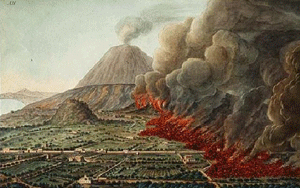Introducing Mountain Building & Volcanism (Volcanoes!)
They tied pillows on top of their heads as protection against the shower of rock. It was daylight now elsewhere in the world, but there the darkness was darker and thicker than any night…(t)hen came a smell of sulfur, announcing the flames, and the flames themselves…he stood up, and immediately collapsed…his breathing was obstructed by the dust-laden air.
—Account by Pliny the Younger of the death of Pliny the Elder in the eruption of Mount Vesuvius in A.D. 79 that destroyed Pompeii and Herculaneum in Italy. [Living with a volcano in your backyard: an educator's guide with emphasis on Mount Rainier]
Supposedly, Atlantis was an island civilization "outside the Pillars of Hercules" and thus located in the Atlantic Ocean, where it was destroyed by an earthquake or tsunami (giant wave) about 11,000 years ago. The source of this information (according to Wikipedia) is an account that Plato wrote in 360 BC of information reportedly given to Solon two hundred years earlier by priests he visited in Egypt. Now, if someone told you that 200 years ago someone else had received information by yet another person regarding something that happened 9000 years earlier, would you immediately believe it? A lot of people apparently do; a search of Google for "Atlantis Plato" finds about 327,000 2.8 million matches, and not all of them are academic discussions.
A better question might be whether there really are islands that disappear below the sea. The answer is yes; many do. Some slide slowly downhill, at about the same rate as your fingernails grow, and disappear first beneath the waves and finally beneath the continents. Others suddenly explode, scattering themselves across the world.
Before we go any further, take a look at the following short video introduction by Dr. Anandakrishnan...
Hey, groovy cats. Welcome to my pad. This is the G-Side 10 '70s show, in which we're going to talk about vinyl, bell-bottoms, platform boots, and most importantly, lava lamps.
What? You mean you don't have a lava lamp? Run down to Uncle Eli's right now and get one. I'll wait.
So what do lava lamps and G-Side 10 have to do with each other? Well, they're a wonderful analog for this whole first section of G-Side 10. First section, if you remember from looking at the syllabus, is building mountains. And the short story for building mountains is heat from within the Earth.
We're going to talk about tearing down mountains later on, but right now we're talking about building mountains, and the heat within the Earth is what drives that whole process. And a lava lamp is a beautiful example of that. Let's take a look at it.
What we have here is a glass tube with some water in it, and then these globules of a slightly different material, and at the bottom, we just have a light bulb that produces heat and heats up the bottom of this glass bowl.
All right, I'm going to take this apart here, and just take a look on the inside. I don't know if this is going to be too bright for you, but we have a light bulb underneath here, and its only purpose is to produce heat and to light up this glass bulb a little bit.
These green globules in here get heated up at the bottom, and as they get heated up, they get less dense. This is fundamentally what's happening inside the Earth. Rocks get heated up at depth, because there's a lot of heat trapped inside the Earth. As they get heated up, they get less dense, and just like these lava lamp globules, they rise up like this one's doing right now, up to the surface of the Earth.
When they get to the surface they cool off, and then, just like this one, they sink back down into the Earth and the whole process goes on and on again. This inside the Earth we would call a convection cell. In a lava lamp, we call it cool.
What to do for Unit 3?
You will have one week to complete Unit 3. See the course calendar for specific due dates.
As you work your way through the online materials for Unit 3, you will encounter a video lecture, several vTrips, some animated diagrams (called GeoMations and GeoClips), additional reading assignments, a practice quiz, a "RockOn" quiz, and a "StudentsSpeak" Survey. The chart below provides an overview of the requirements for this unit.
| REQUIREMENTS | SUBMITTED FOR GRADING? |
|---|---|
|
Read /view all of the Instructional Materials |
No, but you will be tested on all this material. |
| Submit Exercise #1: Scientific Literature | Yes, this is the first of 6 Exercises and is worth 5% of your total grade. |
| Begin Exercise #2: Geology is All Around You | Yes, this is the second of 6 Exercises and is worth 5% of your total grade. |
| Take the Unit 3 "RockOn" quiz | Yes, this is the second of 12 end of unit RockOn quizzes and is worth 4.5% of your total grade. |
| Complete the "StudentsSpeak #4" survey | Yes, this is the third of 12 weekly surveys and is worth 1% of your total grade. |
Questions?
If you have any questions, please feel free to email "All Teachers" and "All Teaching Assistants" through Canvas conversations.
Keep Reading!
On the following pages, you will find all of the information you need to successfully complete Unit 3, including the online textbook, a video lecture, several vTrips and animations, and two overview presentations.

Students who register for this Penn State course gain access to assignment and instructor feedback, and earn academic credit. Information about registering for this course is available from the Office of the University Registrar.
